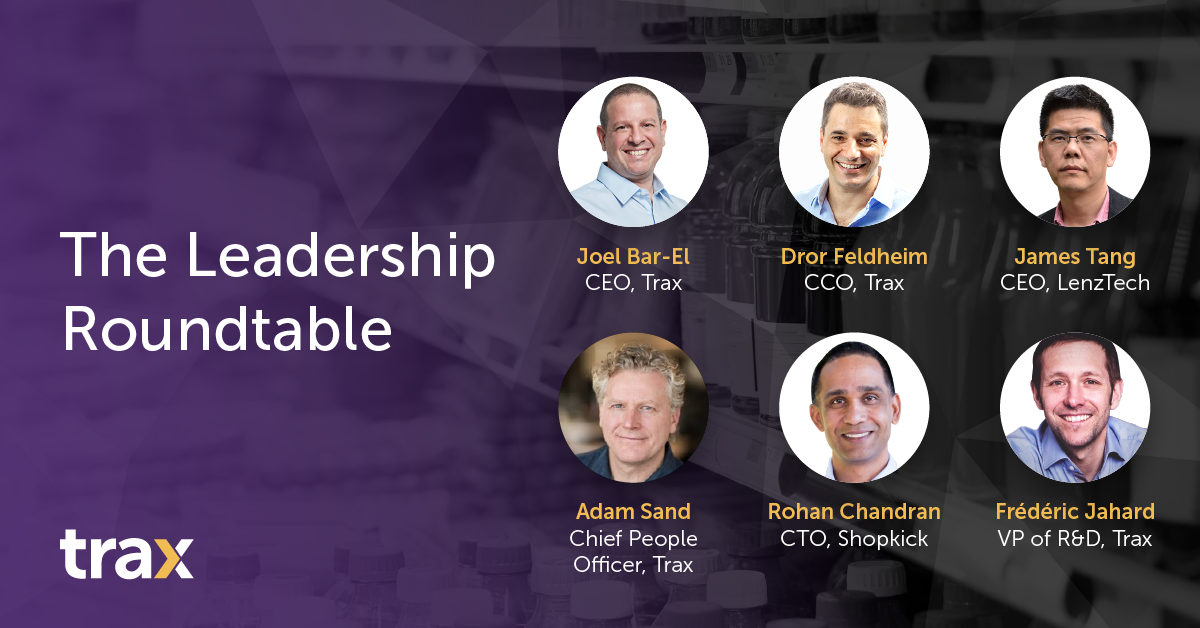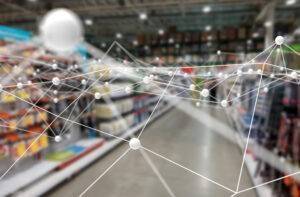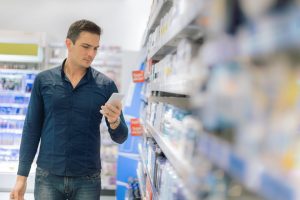Connecting the dots: Trax leaders talk acquisition strategy

It’s been an exciting past few months for Trax, with the company announcing three key acquisitions across as many continents: LenzTech in China, Planorama in Europe and Shopkick in the US. Trax’s vision is to disrupt the retail ecosystem by delivering game-changing technologies, data and analytics, which will guide the industry into a new age of digital transformation. In this Q&A, Trax co-founders, Joel Bar-El, CEO, and Dror Feldheim, Chief Commercial Officer, along with leaders from the newly acquired companies, share the thinking on the strategy behind these acquisitions and the integration process.
- Acquisitions are never easy, and Trax has undertaken three of them in quick succession. Before we peak under the hood to understand what fueled these buys, how do you feel a few months on from the announcements? How’s it all coming together?
Feldheim: We’re taking different approaches to integrating the newly acquired businesses to ensure continuity. For example, in the case of Planorama, both companies are continuing to operate side by side in the short term. With LenzTech, James Tang, the company’s founder and CEO, has taken up the leadership role for all of Trax China. For Shopkick, we plan to keep it as a separate entity within the Trax group. But we’ve already started to find some strong technology and product synergies and soon expect to be able to leverage the best product offerings, algorithms, sales, marketing and execution practices across the companies to create a unified platform.
As substantial as the challenge is, we feel fully geared up to integrate the different businesses, teams and cultures. Apart from commercial, operations and technology teams that are talking to each other, we’ve also created a culture and people stream.
Adam Sand, Chief People Officer at Trax (formerly CEO of Shopkick): One thing I want to highlight is that Trax is doing something great by putting the leaders of the newly acquired companies in charge. This isn’t typical and it will help with any future acquisitions.
- What has been the overarching strategy behind these recent acquisitions?
Bar-El: Our long-term vision is to digitize the physical world of retail and drive value for the three major parties of the industry globally: brands, retailers and shoppers. And we believe these acquisitions will shorten the time to achieve that vision. Each one of them represented a different strategic value for the company. These acquisitions will also widen the breadth of our product portfolio as we onboard many new applications and technologies.
- Considering China and its “new retail” revolution, how do you see your new positioning there with the Trax-LenzTech transaction now complete?
Feldheim: China’s retail sales in 2019 will surpass those of the US by more than $100 billion, making the country the world’s top retail market. When you look at how digitally savvy and demanding China’s consumers are and how flexible and technology-driven retailer distribution models are, it’s easy to see why China is leading the way in delivering innovative in-store experiences. For consumer packaged goods (CPG) brands, the ability to stay on top of what’s needed at shelf is more critical than ever. In many ways, shelf data is really the final frontier of this digital revolution. This is the context for why our acquisition of LenzTech is so significant.
James Tang, Chief Executive Officer, LenzTech: LenzTech has a strong R&D team and a crowdsourcing workforce with nearly a million registered members. Of those, about 800,000 are active subscribers. These are essentially consumers who put the power of AI into monitoring in-store conditions in more than 1,000 cities, including all counties and most townships across China. Whether you’re a local brand or a global giant, the auditing efficiency and insights at scale that you get from our combined platform are pretty unprecedented.
Another massive gain is that we now have an R&D center in China, which we’ve wanted for a long time, to better serve the Chinese market.
- Planorama is Trax’s most recent acquisition. What motivated this partnership?
Feldheim: Planorama is the leading European provider of image recognition for shelf-space planning and merchandizing for CPGs and was a direct competitor. So, the company is a natural partner for us. Across the combined teams of Trax and Planorama, we can now apply robust computer-vision expertise to retail. Planorama brings more than 90 customers from 53 countries, and this greatly enhances our client base as well as our enterprise-user base.
- What can customers, both existing and new, expect from this acquisition?
Frédéric Jahard, Chief Innovation Officer, Planorama: The thing that I’ve begun to notice is that although we are similar companies, there are differences in the way we’ve both evolved. For example, the product team in Planorama was built by bringing in members of the operations unit. Many people in leadership positions come from consulting-led companies. So, project management has been their forte. At Trax, technical competency and product scalability have been a focus. These complementary strengths will add a lot of value to our customers.
Feldheim: Our multi-phase integration roadmap is very clear. Our technology, infrastructure and solution capabilities will gradually converge, but with zero adverse impact on customers. Soon we will have a unified catalog of extended back-end capabilities allowing for superior performance, and advanced front-end products bespoke to the use case of our user personas. Our objective is to take the best of both Trax and Planorama’s products and technologies to offer the most robust portfolio of CPG solutions for shelf excellence globally.
- Your product portfolio has become bigger, but also more complex. How do you expect the market to react?
Bar-El: What we’ve seen is that the systemic issues that consumer goods companies face at retail affect many teams – from commercial to marketing and strategy. One of the great things about Trax and Planorama coming together is that we’re now able to help more teams than ever before solve these problems. On top of taking advantage of our in-store execution and analytics suite of solutions, customers can now access merchandizing and shelf-space recommendations that work best with shoppers.
The main thing to remember is that the guiding mission of both companies has been exactly the same from day one. With our extended portfolio, we expect to attract an even broader range of customers, in terms of company size or categories; we’ll also deepen our relationships with existing clients.
- Today, the market perceives Trax more as a data and insights company than as a software company. Is this the deliberate direction you’re moving toward, and if so, how do the acquisition announcements help?
Feldheim: Data is at the center of all technologies today, so we don’t see these as mutually exclusive. Every executive we’ve spoken to, from either a brand or a retailer, wants to gain richer customer insights by digitally capturing customer interactions. They consistently speak about the imperative to begin digitalizing the full breadth of offline experiences. And that’s the theme to our acquisitions in that they have focused on building both data and technology leadership – for example, assimilating customer data from Shopkick, using crowds as resources for data collection from LenzTech and incorporating tech solutions from Planorama.
- Shopkick is an interesting buy; it’s the only one that directly reaches the shopper in the store. How does it work?
Bar-El: Shopkick has an interesting model; it creates a fun shopping experience fueled by “kicks” (the app’s own currency, or points, system) that reward shoppers for doing all the things they normally do. This might include browsing for content and online offers, watching videos, walking into stores, or engaging with and purchasing products both online and offline.
About 70 percent of shopper activities are product scans: shoppers find specific products in-store and then scan the barcode. Sometimes they take a picture of the product itself.
Rohan Chandran, Chief Technology Officer, Shopkick: To elaborate, we use electronic beacons and GPS to detect when people walk into stores. We then incrementally increase the rewards points they get – for example, when shoppers pick up a product from the shelf and scan it. And when they finally purchase a product, the rewards further escalate, and they can redeem their points as gift cards in the same store.
The idea is to keep customers coming back to stores as well as to make shopping delightful, with fun elements, such as people completing scan missions at stores, competing with each other through gamification and being part of a community.
- This certainly sounds appealing for the customer. But what’s in it for brands and retailers?
Chandran: For retailers, the Shopkick model is a great way to drive return visits and shopper loyalty. Unlike your regular discount offers and coupons, the app encourages repeat behavior and engages customers, no matter where they are in the sales funnel. For example, if a consumer is walking into a store and not buying, we can nudge them into checking out products by incentivizing them for that. And if they’re considering the product but not buying, we offer add-on incentives.
This ability to influence customer behavior is exciting for brands.
- How does the collaboration with Shopkick give Trax an edge?
Bar-El: Shopkick will help us establish a direct relationship with consumers; as a leading shopping-rewards app, it provides high consumer engagement for brands and retailers in the US. And now we’ll be able to tap into its pool of millions of active users to expand our crowdsourcing presence in the US.
This will also allow us to capture coveted first-party data and funnel insights, such as purchasing behavior and in-store and online trends. The reference images collected in the field can aid our unsupervised learning algorithms and perfect our computer vision with less image annotation.
Think of it also as a low-cost opportunity for us to use product images and nutritional data to shape future capabilities of our Trax Retail Watch.
I can tell you, we certainly have an interesting time ahead of us!



